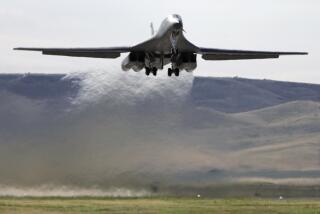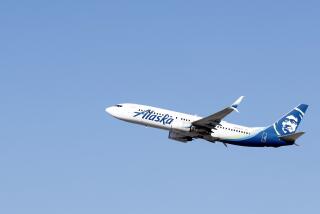B-1 Fixes to Top $1 Billion, Panel Is Told : Defense: GAO official gives estimates on avionics, de-icing and fan blade changes. Lawmakers are told improvements may not be finished until 1994.
- Share via
WASHINGTON — Persistent problems affecting the B-1 bomber’s radar, electronics, engine blades and other systems will take several years and more than $1 billion to fix, members of Congress were told Wednesday.
The B-1 lacks effective defensive avionics and de-icing systems, and its engines must be visually inspected after every flight for cracks in the front fan blades, a government auditor told members of a House Government Operations subcommittee.
“It is seriously limited in terms of its intended capability,” said Nancy Kingsbury, director of Air Force issues for the General Accounting Office, the investigative arm of Congress.
The controversial bomber, designed to carry nuclear weapons deep inside Soviet territory, has been plagued by numerous problems since its introduction in 1986, including three crashes. The Air Force purchased 100 of the planes at a total cost of about $30 billion.
When the U.S.-led coalition launched the air war against Iraq in mid-January, the fleet of 97 B-1s was grounded while the Air Force investigated two engine failures caused by cracked fan blades. The coalition relied instead on older B-52s and other allied aircraft.
But Kingsbury said the B-1 would not have been used in Operation Desert Storm even if it had been available because additional testing is necessary before the bomber can conduct conventional bombing missions.
“This bomber is certified and used as a nuclear bomber,” she said. “It would not have been appropriate to use it in the Gulf.”
Equipping the bomber with an avionics system capable of jamming enemy radar could cost as much as $830 million, Kingsbury said, while installing a de-icing system on the B-1 fleet would cost up to $200 million.
Fixing the plane’s engines, designed by General Electric, could cost as little as $10 million or as much as $500 million, Kingsbury said, depending on whether a simple solution to the blade problems can be found or whether the engine must be completely redesigned.
But Air Force officials asserted that the problems can be corrected and that the plane will justify the additional investment.
“The B-1 is the most accurate long-range bomber in the world today,” said Maj. Gen. Richard Hawley, director of operations headquarters for the U.S. Air Force.
Several members of the subcommittee, however, said the government should take a long, hard look at the future of the plane.
“Not one of these aircraft can do the job it was designed to do,” said Rep. John Conyers Jr. (D-Mich.), who referred to the planes as “$300-million paperweights.”
Kingsbury said that all of the improvements needed to make the B-1 fully operational would not be completed until 1994 at the earliest, and could take as long as a decade. Contributing to the delays is last week’s announcement that the avionics system contract with AIL Systems Inc. of Deer Park, N.Y., a subsidiary of the Eaton Corp., would be canceled because the Air Force lacks the funds to continue the program.
Charles Baron, president and chief executive of AIL, told the committee that the cancellation of his company’s contract could result in further delay in installing the radar systems and add $150 million to $170 million to the program’s cost.
The contract cancellation, expected to be made official Friday, will force AIL to fire 700 employees immediately and up to half of its staff of 3,400 if the delay is protracted, Baron added.
More to Read
Inside the business of entertainment
The Wide Shot brings you news, analysis and insights on everything from streaming wars to production — and what it all means for the future.
You may occasionally receive promotional content from the Los Angeles Times.










